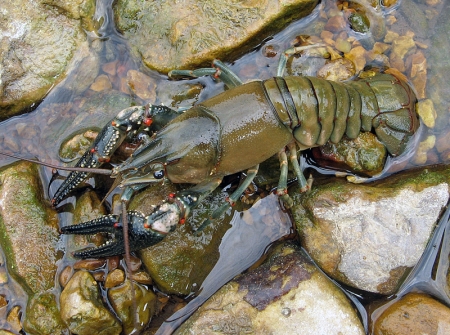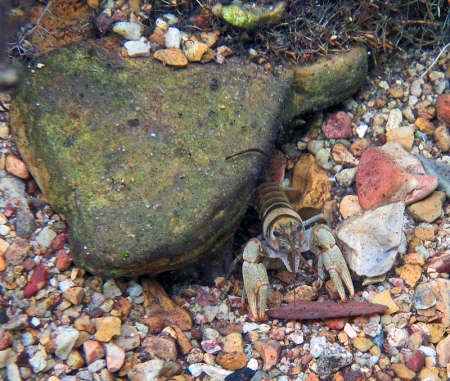I hinted at it in my last post, but I’ve become completely fascinated (Dayna would call it obsessed) with crayfish. Why, you ask? Because they’re so cute and cuddly? Well, no, not even the most dedicated astacologist would ever call a crayfish cute or cuddly, but I do think they’re beautiful. Mostly subtle shadings of browns, olives, tans and the occasional yellow but often featuring red trimming and highlights, crayfish tend to be colored to blend into the background in a world where standing out gets you eaten. But there is beauty in subtlety and we do have a couple of showy species if you happen to need a spectacle.
Regularly reaching 6” in body length and exceeding 10” including the pincers, Orconectes longidigitus is one of those showy species
Missouri has in the neighborhood of 35 species of crayfish, so there is enough variety to make them interesting, but not so many that they’re overwhelming. Of those 35 or so species, about 25 occur here in the Ozarks where I concentrate my efforts. Many species are very localized in their distribution, occurring only in Missouri or possibly to a limited degree in adjoining states. A few are limited to a single stream or two. It’s not uncommon for adjacent drainages to have completely different crayfish assemblages or share only a species or two.
Orconectes luteus, one of the most common, widespread species in the Ozarks.
Crayfish are easy to study. All you really need is access to a body of water, preferably a stream if you’re in the Ozarks – any size will do – and you’re likely to find crayfish. You can use a minnow seine, crayfish trap or a dipnet, but all you really need are your hands to catch crayfish. I have a 16” dip net that I use occasionally, but find the 8” bait well net that you can find at Wal-mart for $5 to be much handier, especially if I’m snorkeling.
You can take up to 150 crayfish per day in Missouri if you have a fishing permit, but there is a caveat to that. There are currently nineteen species of crayfish on the Missouri Species of Conservation Concern Checklist, which means that you cannot take them unless you are the holder of a Wildlife Collector’s Permit. So if you happen to be interested in collecting crayfish, more than half of our species are basically off limits. The species on the Conservation Concern Checklist are shown in the table below.
|
Scientific Name |
Common Name |
| Cambarellus puer | Cajun Dwarf Crayfish |
| Cambarellus shufeldtii | Shufeldt’s Dwarf Crayfish |
| Cambarus aculabrum | Cave Crayfish |
| Cambarus hubrichti | Salem Cave Crayfish |
| Cambarus ludovicianus | Painted Devil Crayfish |
| Cambarus maculatus | Freckled Crayfish |
| Cambarus setosus | Bristly Cave Crayfish |
| Fallicambarus fodiens | Digger Crayfish |
| Faxonella clypeata | Shield Crayfish |
| Orconectes eupunctus | Coldwater Crayfish |
| Orconectes harrisonii | Belted or Big River Crayfish |
| Orconectes lancifer | Shrimp Crayfish |
| Orconectes marchandi | Mammoth Spring Crayfish |
| Orconectes meeki meeki | Meek’s Crayfish |
| Orconectes peruncus | Big Creek Crayfish |
| Orconectes quadruncus | St Francis River Crayfish |
| Orconectes stygocaneyi | Caney Mountain Cave Crayfish |
| Orconectes williamsi | Williams’ Crayfish |
| Procambarus viaeviridis | Vernal Crayfish |
Finally, if you have any interest in crayfish at all, you should go to the Missouri Department of Conservation’s Nature Shop and grab a copy of William Pflieger’s Crayfishes of Missouri. At five dollars, it is an absolute steal even though it was published in 1996 and is beginning to show signs of taxonomic age.
In the last few months, I’ve been all over the Missouri Ozarks (and the Lowlands) chasing and photographing crayfish, so you can expect many more crayfish related posts in the future. Again, I hope you like crayfish!


Well—you’ve peaked my curiosity about these creatures. I could, if better acquainted, maybe come to like them more than “sort of”. Their articulated segmented coats are quite amazing. I too admire a creature that has evolved a discrete physical appearance that mimics it’s habitat. One’s natural surroundings are worthy of imitation—whether or not it lessens the chance of turning up for someone’s dinner. As a species, one might wonder how humans will turn out. Will we come to take on the characteristics of our surroundings? We are already well on the way to becoming something very “unnatural”. I must make a point to spend more time outside!